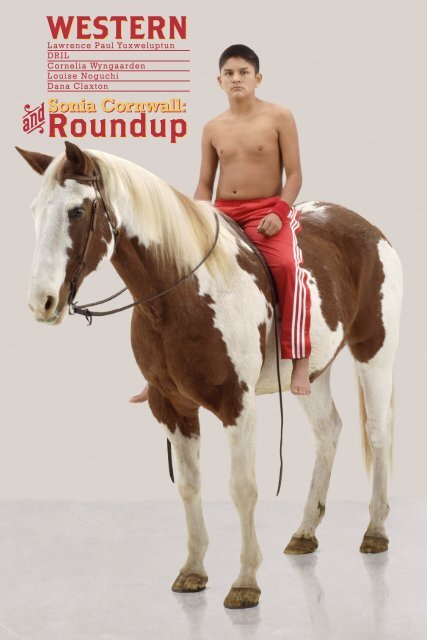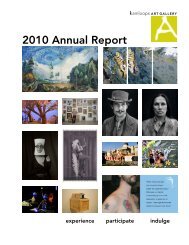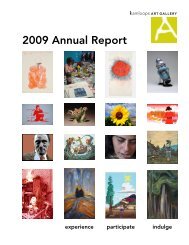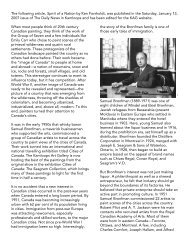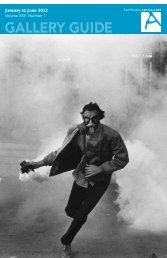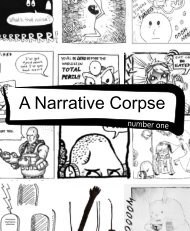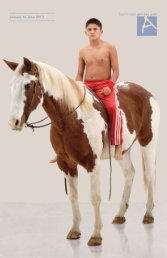Western & Sonia Cornwall - Kamloops Art Gallery
Western & Sonia Cornwall - Kamloops Art Gallery
Western & Sonia Cornwall - Kamloops Art Gallery
Create successful ePaper yourself
Turn your PDF publications into a flip-book with our unique Google optimized e-Paper software.
WESTERN<br />
Lawrence Paul Yuxweluptun<br />
DRIL<br />
Cornelia Wyngaarden<br />
Louise Noguchi<br />
Dana Claxton<br />
<strong>Sonia</strong> <strong>Cornwall</strong>:<br />
Roundup<br />
1
Online publication of exhibitions organized by the <strong>Kamloops</strong> <strong>Art</strong> <strong>Gallery</strong>, January 18 to March<br />
23, 2013.<br />
<strong>Western</strong> is curated by Charo Neville, KAG Curator and <strong>Sonia</strong> <strong>Cornwall</strong>: Roundup is curated by<br />
Roger Boulet.<br />
The <strong>Kamloops</strong> <strong>Art</strong> <strong>Gallery</strong> is a registered not-for-profit society. We gratefully acknowledge<br />
the financial support of City of <strong>Kamloops</strong>, Province of British Columbia through the British<br />
Columbia <strong>Art</strong>s Council and Gaming Information and Services, The Canada Council for the <strong>Art</strong>s,<br />
Department of Canadian Heritage, foundation grants, corporate donations and sponsorships,<br />
general donations and memberships.<br />
This exhibition was sponsored by Funk Signs, the BC Cattlemen’s Association and The Plaza<br />
Hotel. As a non-profit organization, the <strong>Kamloops</strong> <strong>Art</strong> <strong>Gallery</strong> relies on the contributions of our<br />
supporters. Donations to the gallery can be made by visiting us here –<br />
kag.bc.ca/supportus.htm<br />
©<strong>Kamloops</strong> <strong>Art</strong> <strong>Gallery</strong>, the authors and artists, 2013<br />
Designer: Ross Macaulay<br />
Front cover: Dana Claxton, Baby Boyz Gotta Indian Pony, 2008, C print, 60”x48”<br />
Back cover: DRIL, detail of Move it On Over, 2011 -
WESTERN<br />
<strong>Sonia</strong> <strong>Cornwall</strong>:<br />
Roundup
Lawrence Paul Yuxweluptun, detail of An Indian Act Shooting the Indian Act, 1997<br />
4
WESTERN<br />
January 18 to March 23, 2013<br />
The <strong>Kamloops</strong> <strong>Art</strong> <strong>Gallery</strong>’s 2013 exhibition program focuses its attention on the idea<br />
of “place.” Situated within active ranching country, the first exhibitions of the year look at<br />
how the mythology of the West has developed in this region and opens up a conversation<br />
about our relationship to this place. <strong>Western</strong> brings together key works by artists who have<br />
addressed the idea of the “west” and the “western” in diverse and complex ways. It offers<br />
us an important opportunity to feature key works from the KAG’s permanent collection with<br />
work from other significant contemporary artists who have addressed this subject.<br />
This group exhibition aims to take stock of the history of settlement in the west and to<br />
reflect upon how this history and its manifestations have shaped the popular imagination.<br />
It includes an absurd and yet strongly metaphorical large-scale installation by the artist<br />
collective DRIL that features the tumbleweed as the main protagonist. It also comprises a<br />
provocative work from the KAG’s permanent collection by Cornelia Wyngaarden that plays<br />
on the sexual stereotype of the “Marlboro Man,” as well as the resulting installation from<br />
Lawrence Paul Yuxweluptun’s polemical performance An Indian Act Shooting the Indian Act,<br />
also from the KAG’s collection. Dana Claxton’s Mustang Suite photographs, produced like slick<br />
advertisements, portray the complexities and contemporary realities of the “Indian” family<br />
through hybrid portraits. The exhibition also features Louise Noguchi’s complete early video<br />
series Language of the Rope, in which the artist studies the phenomenon of re-staged and reenacted<br />
cowboy culture.<br />
At times exaggerating these inherited and ingrained mythologies, the work in the exhibition<br />
challenges the “western” trope from multivalent perspectives, offering an un-romanticized<br />
pithy view of relations between cowboys, the North American frontier and First Nations<br />
peoples. In conjunction with the exhibition of paintings by artist and rancher, <strong>Sonia</strong> <strong>Cornwall</strong>,<br />
the exhibition re-frames the “Wild West” as an ideological space through a post-colonial lens<br />
of East and West and male and female. This key grouping of <strong>Cornwall</strong>’s work, curated by<br />
Roger Boulet, offers insight into life on a ranch near <strong>Kamloops</strong> and demonstrates the artist’s<br />
dedication to depicting the landscape and everyday scenes.<br />
Curated by Charo Neville, KAG Curator<br />
5
LAWRENCE PAUL YUXWELUPTUN<br />
An Indian Act Shooting the Indian Act, 1997<br />
Collection of the <strong>Kamloops</strong> <strong>Art</strong> <strong>Gallery</strong>. Purchased with the support of the Canada Council<br />
for the <strong>Art</strong>s Acquisition Assistance program. The performance and exhibition were originally<br />
produced by grunt gallery, Vancouver and Locus+, Newcastle.<br />
Lawrence Paul Yuxweluptun was born in <strong>Kamloops</strong>, BC in 1957 and grew up in the Vancouver<br />
area. Yuxweluptun is well known for his large-scale acrylic paintings that incorporate Coast<br />
Salish cosmology, Northwest Coast formline design and hybrid imagery. His work addresses<br />
contemporary First Nations political and social issues such as land claims, the treaty process<br />
and environmental, spiritual and economic concerns that have resulted due to colonization.<br />
In 1997, for An Indian Act Shooting The Indian Act, Yuxweluptun traveled to the United Kingdom,<br />
where he literally shot copies of the Indian Act using a .308 rifle and three 12-gauge shotguns<br />
on two different sites—at the National Rifle Association Range in Bisley and on a private estate<br />
in Healey, Northumberland.<br />
With its roots in the British North America Act, first manifested as The Royal Proclamation<br />
of October 7, 1763, the Indian Act was created in 1876, as a statute that governs registered<br />
Indians, their bands and the reserve system. British Columbia, unlike many other parts of<br />
Canada, did not sign treaty agreements with First Nations; rather than compensating them<br />
for their land, First Peoples were consigned to reserves. In his artist statement for this project,<br />
Yuxweluptun writes:<br />
“I have come over to this country to express my feelings towards the Indian Act, which was<br />
written by non-Natives representing the colonial interests of this empire. This performance<br />
is a symbolic act of how much hatred, anguish and anger that I have towards this legislation.<br />
I am symbolically trying to extinguish Canadian colonial supremacy over Aboriginal people<br />
by showing a physical act in spirit that some day this type of legislation will no longer exist<br />
on the face of this sacred mother earth. Aboriginal people are human beings and deserve<br />
the same dignity and equalities as all other Canadian citizens, we deserve the right to selfdetermination,<br />
self-government and self-rule.”<br />
On the walls of this installation, Yuxweluptun asserts his own proclamation dates. In this<br />
direct and yet symbolic gesture, he re-channels the history of violence and discrimination that<br />
has been inflicted on First Nations people onto an inanimate object that embodies the values<br />
of this oppression, thereby enacting an empowered political position.<br />
*source: Archer Pechawis, “New Traditions: Post-Oka Aboriginal Performance <strong>Art</strong> in<br />
Vancouver,” 2010 (www.indianacts.gruntarchives.org).<br />
7
DRIL<br />
Move It On Over, 2011 -<br />
Installation<br />
DRIL is a collective of four artists based in Vancouver. Their collaborative practice is concerned<br />
with the politics of space and has involved projects that look at how histories have affected<br />
our contemporary notions of place.<br />
This is the third incarnation of DRIL’s installation Move It On Over, 2011- , first installed at<br />
Shudder <strong>Gallery</strong> in Vancouver and then at Open Space in Victoria. The installation and video<br />
work, Goodbye California, feature the tumbleweed as the main protagonist, highlighting the<br />
longstanding iconic and metaphoric position the plant holds within the public imagination.<br />
The video presents a catalogue of these instances within film history. Highly mediated and<br />
constructed, the identity of the tumbleweed has associations within the “western” genre of<br />
20th century cinema — most often proliferated in Hollywood productions as a symbol of the<br />
desolate Wild West. The presence of the tumbleweed typically conveys a sense of impending<br />
conflict (a shoot out or “bad” guys coming through town). Characteristically paired with lone<br />
whistling or harmonica-driven soundtracks, the tumbleweed has come to symbolize a barren<br />
and transient landscape, that of the new and lawless frontier.<br />
DRIL has removed the tumbleweed from its natural environment into a gallery context in<br />
an installation that mimics a theatrically staged film set so the mechanisms of media, filmic<br />
conventions and the museological viewing context are revealed and un-naturalized. The<br />
installation is meant to immerse the viewer in an entirely new environment. As DRIL presents<br />
it, the exaggeratedly anthropomorphized tumbleweed sitting alone in an armchair watching<br />
its own image or grouped together as a massive overgrowth guiding our passage through<br />
the installation, humourously brings its constructed and culturally naturalized identity into<br />
question. The immaculately designed and nostalgic living room setting for viewing Goodbye<br />
California also works to reframe our relationship to these well-established associations with<br />
the tumbleweed and the “western” genre.<br />
DRIL has flipped the symbology of this plant to provide a more critical reading of the West.<br />
The commonly-known tumbleweed is actually the Russian thistle, accidentally introduced to<br />
California and the West Coast by immigrants; it is a hardy and invasive species that chokes<br />
out diversity as it grows. Once it matures and dries up, the plant breaks off its root system and<br />
tumbles far distances dropping its seed as it goes. In this way, the plant can be understood as<br />
a metaphor for diaspora and for histories of colonization that radically changed the landscape<br />
of the West.<br />
*source: Jeremy Borsos, Drifter’s Clip (Victoria: Open Space <strong>Art</strong>s Society), 2011.<br />
9
CORNELIA WYNGAARDEN<br />
As a Wife Has a Cow, 1985<br />
Video installation<br />
45 min loop<br />
Collection of the <strong>Kamloops</strong> <strong>Art</strong> <strong>Gallery</strong><br />
Cornelia Wyngaarden is a Vancouver-based artist. She has been referred to as a “well known<br />
cultural dissident and an important voice of Canadian feminism.” Wyngaarden pioneered<br />
the development of new media in contemporary art through her own video work and her<br />
early advocacy that supported innovations in the new media community at institutions<br />
such as Video In/Out and The <strong>Western</strong> Front in Vancouver. Throughout her art practice, she<br />
has produced compelling and politically charged video works and experimental sculptural<br />
installations.<br />
Wyngaarden’s practice draws on lived experience and archival research. It explores cultural<br />
mythologies through traditional documentary forms that are then presented in nontraditional<br />
viewing situations. Her work is rooted in queer and feminist theory and seeks to<br />
disrupt the normalcy of straight culture. Gender role reversal and cross-dressing are common<br />
themes in Wyngaarden’s work, serving as a means for deconstructing stereotypes and cultural<br />
norms.<br />
As a Wife Has a Cow is a portrait of rancher Kelly Moll. The video disrupts the traditional<br />
stereotypes of the “Marlboro Man” in the “western” film genre by featuring a strong female<br />
protagonist, or “Marlboro Woman,” who is clearly comfortable in her own skin and is shown<br />
in her own environment, living and working on the land. In contrast to the slow-motion yet<br />
more aggressive scenes of men at the rodeo, Moll tells her stories and moves within her world<br />
with ease. Many of her stories are about men, and the intercut images show a man’s world.<br />
Through these stories, uninterrupted by the interviewer, the videos reveal Moll’s world view<br />
and character, both shaped by and divergent from the masculine archetype. Wyngaarden<br />
simultaneously uses the mechanisms of and thereby deconstructs “western” pictorial<br />
representation by presenting a matter-of-fact portrait of an alternative, independent and<br />
transgressive female protagonist.<br />
*source: Cornelia Wyngaarden: The Fragility of Origins (Vancouver: <strong>Western</strong> Front Society),<br />
1994.<br />
11
LOUISE NOGUCHI<br />
Language of the Rope series, 1998-2005<br />
DVDs<br />
Rope Tricks<br />
Gun Play<br />
When You Fall off Your Horse<br />
Louise Noguchi lives and works in Toronto, Ontario. Her practice encompasses a variety of<br />
mediums and explores research interests such as subcultures and their histories. The content<br />
investigated in her work often challenges or poses psychological questions to the viewer and<br />
confronts the spectator’s notions of identity, perception and reality.<br />
In the Language of the Rope series, Noguchi delves into her fascination with the mythology<br />
of the North American cowboy and contemporary remnants of Wild West culture through<br />
extensive travels to commercial Wild West theme parks in the United States. In the vain of<br />
the European circus, this form of entertainment was initiated by William Cody (Buffalo Bill) in<br />
1883 as a thrilling and seductive spectacle. In Wild West theme parks such as Six Gun City in<br />
Jefferson, New Jersey and Donley’s Wild West Town in Union, Illinois, the cowboy persona is<br />
glorified on a theatrical stage. In contrast to the gratuitous violence in Hollywood films today,<br />
the focus in these theme parks is on talent and skill and, similar to the “western” film genre,<br />
the re-enactments evoke romantic associations with the cowboy. In Noguchi’s videos, she<br />
emphasizes this seductive quality and reframes these activities in new ways by slowing down<br />
and zooming into the action.<br />
Noguchi’s interest in this culture took her to numerous Wild West theme parks across the<br />
USA over many years and she herself studied the arts of trick roping, knife throwing, bullwhip<br />
cracking and trick riding with Tom Bishop Junior, a professional Wild West performer.<br />
Noguchi is visible in the video Rope Tricks performing her lassoing skills. As a Japanese<br />
woman, Noguchi subverts our expectations of who a cowboy or cowgirl can be. There is a<br />
similar gender crossover in Gunplay, which features a tightly cropped close-up of a tattooed,<br />
black nail-polished performer showing off gun twirling tricks. In When You Fall off Your Horse,<br />
ironically the professional trick rider demonstrates how to fall off his bucking horse, rather<br />
than how well he can stay on.<br />
All these tricks are outside the less glamourous realm of the day-to-day activities of an actual<br />
rancher and instead situate this culture in the milieu of entertainment. The three videos<br />
highlight questions about historicity in relation to the performative by bringing to light the<br />
phenomenon of re-staged “western” culture. In her slow-motion vignettes, Noguchi offers<br />
pause to consider the ways in which this well-established “western” genre has become a<br />
common fixture in the public imagination.<br />
*source: Dazibao press release for document exhibition, 2011.<br />
13
DANA CLAXTON<br />
The Mustang Suite<br />
Baby Boyz Gotta Indian Pony, 2008<br />
C print, Collection of the <strong>Art</strong>ist<br />
Baby Girlz Gotta Mustang, 2008<br />
C print, Collection of the <strong>Art</strong>ist<br />
Daddy’s Gotta New Ride, 2008<br />
C print, Private Collection, Vancouver<br />
Momma Has A Pony...(Girl Named History and Sets Her Free), 2008<br />
C print, Collection of the <strong>Art</strong>ist<br />
Family Portrait...(Indians on a Blanket), 2008<br />
C Print , Collection of the <strong>Art</strong>ist<br />
Dana Claxton is an interdisciplinary artist of Hunkpapa Lakota Sioux ancestry currently based<br />
in Vancouver. Her work uses metaphor and symbology to examine frameworks for race and<br />
identity and addresses the destruction and commodification of First Nations culture.<br />
In The Mustang Suite Claxton provides a tongue-in-cheek staging of Indigenous portraits,<br />
presenting hybrid images of traditional and present day identities. The Mustang is a fast<br />
and free spirited horse associated with the history of the Americas and the Wild West. When<br />
reintroduced to America by the Spanish in the 1600s, the horse transformed the lives of the<br />
Plains and Prairies First Nations people. Claxton’s suite of five photographs of this name mark<br />
the significance of this animal in relation to colonization in affecting the trade, mobility and<br />
interaction between First Nations and settlers during the expansion of the West.<br />
Claxton’s slickly produced photographs, reminiscent of high-end advertising, portray the<br />
complexities and contemporary realities of the modern “Indian” family; she mixes value<br />
systems and status symbols by replacing the horse with a pony, vintage bikes and a Ford<br />
Mustang and by merging traditional moccasins, headdresses and face paint with the<br />
contemporary business suit and track pants. The portraits point to generational gaps, shifts in<br />
sexual proclivities and consumerist motivations. In conveying the complexities of the modern<br />
Aboriginal, Claxton provides portraits of strength, endurance and power through the use of<br />
the dominant traditional red colour and the confident gaze, which holds the viewers attention.<br />
*sources: Face The Nation (Edmonton: <strong>Art</strong> <strong>Gallery</strong> of Alberta), 2008. Amber Berson, “Dana<br />
Claxton, The Mustang Suite and Hybrid Humour” (<strong>Art</strong>ial: <strong>Art</strong> & Social Colloquium, June 23,<br />
2010).<br />
15
<strong>Sonia</strong> <strong>Cornwall</strong>, Sign of Spring, 2002<br />
16
<strong>Sonia</strong> <strong>Cornwall</strong>: Roundup<br />
January 18 to March 23, 2013<br />
A number of the ranchers in the Cariboo country were educated sons of well-to-do British<br />
families who came to Canada seeking economic opportunities. Such was the case of the Irishborn<br />
Charles G. Cowan (1868-1939) who established himself in <strong>Kamloops</strong> as a land agent in<br />
the early 1900s after serving in Canada’s North-West Mounted Police. In 1918, Cowan married<br />
Vivien Tully (1893-1990) who had been visiting from Portland. Two years later, they bought<br />
the Onward Ranch. Well educated before marriage and settling into ranching life, the Cowans<br />
continued to value cultural activities and made sure that their daughter <strong>Sonia</strong>, already<br />
acquainted with painting as a child, received a good education. After the death of her father in<br />
1939 in Victoria where the Cowans often spent the winter, <strong>Sonia</strong> and her mother returned to<br />
the Onward Ranch, which they continued to operate in order to make ends meet.<br />
Wishing to pursue studies in art after <strong>Sonia</strong> had grown up, Vivien Cowan attended the Banff<br />
School of Fine <strong>Art</strong>s in 1945 where she met A.Y. Jackson, one of the founding members of<br />
the Group of Seven. Jackson accepted Cowan’s invitation to visit the ranch and became a<br />
regular visitor. Both mother and daughter benefited from his example and by that of a steady<br />
stream of artist-visitors who came to give classes and workshops. <strong>Sonia</strong> attended art school<br />
in Calgary for some months in 1946, but soon returned to the ranch and to the life she loved.<br />
She married Hugh <strong>Cornwall</strong> (1912-2001) of Ashcroft in 1948. <strong>Sonia</strong> did not always have time to<br />
paint, especially when her daughters were growing up, but after the sale of the Onward ranch<br />
in 1966, the <strong>Cornwall</strong>s settled on the Jones Lake Ranch and <strong>Sonia</strong> was able to devote more of<br />
her time to painting, often spending at least a couple of hours a day in her studio.<br />
Because <strong>Sonia</strong>, like her mother, had been active in the routine work of ranch life, these<br />
everyday activities would become central to <strong>Cornwall</strong>’s work. Her paintings have a striking<br />
raw, gutsy quality. Her approach to art making is very personal, speaks for itself and<br />
expresses its subject frankly and without pretension. Her work is the product of a life which<br />
combined the routine of a working ranch and an unspoken sophistication gleaned from a<br />
lifetime of reading, looking at works of art and of constant exchange with other artists.<br />
Curated by Roger Boulet<br />
With assistance from Paul Crawford (Director/Curator, Penticton <strong>Art</strong> <strong>Gallery</strong>) and Julie Fowler<br />
(<strong>Art</strong>swells Festival Executive Director/Curator) and special acknowledgement to the Estate of<br />
<strong>Sonia</strong> <strong>Cornwall</strong> and the Penticton <strong>Art</strong> <strong>Gallery</strong> for lending the selected works.<br />
17
1<br />
2<br />
3<br />
4<br />
7 8<br />
5<br />
6<br />
1.<br />
2.<br />
3.<br />
4.<br />
5.<br />
6.<br />
7.<br />
8.<br />
Untitled (three cows resting in poplar grove), n.d.<br />
Evening Light, 2002<br />
Sign of the Spring, 2002<br />
Curiosity, 2001<br />
Resting in the Heat, 2002<br />
Territorial Fight, 2001<br />
Indoor Rodeo, 1993<br />
Untitled (roundup), 1996<br />
* all works oil on board unless otherwise indicated<br />
18
9<br />
10<br />
11<br />
12<br />
15 16<br />
13<br />
14<br />
9.<br />
10.<br />
11.<br />
12.<br />
13.<br />
14.<br />
15.<br />
16.<br />
What is the <strong>Art</strong>ist Doing, 1971<br />
Untitled (cattle, pines, landscape), n.d.<br />
Late Sun on the Winder Feed Lot, 1991<br />
oil on masoninte<br />
March of the Cows, 1991<br />
Working Cattle, 1971<br />
Jones Lake Ranch, n.d.<br />
Untitled (grazing cattle), n.d.<br />
Cattle on the Feed Grounds, 1969<br />
oil on masonite<br />
Collection of the <strong>Kamloops</strong> <strong>Art</strong> <strong>Gallery</strong>, Gift of the <strong>Kamloops</strong> <strong>Art</strong>s & Craft Club<br />
19
1 2 6<br />
3 4 7<br />
5<br />
1.<br />
2.<br />
3.<br />
4.<br />
5.<br />
6.<br />
7.<br />
Untitled (three horses with tree), 1999<br />
Horses in the Rye Grass, 2002<br />
Untitled (horses at the pasture), 1998<br />
After Dinner Rest, 1998<br />
Untitled (horses in the corral), 1970<br />
Big Stuff, 1973<br />
Our Corrals, 1978<br />
* all works oil on board unless otherwise indicated<br />
20
9 12<br />
8 11<br />
10 13<br />
8.<br />
9.<br />
10.<br />
11.<br />
12.<br />
13.<br />
Rural Sites, 1986<br />
oil on canvas<br />
Storm 1965<br />
A Corner of the Garden, 1981<br />
Ring Around the Sun, 1970<br />
Early Spring, 1998<br />
The Barn, n.d.<br />
21
<strong>Sonia</strong> <strong>Cornwall</strong>, Curiosity, 2001<br />
<strong>Sonia</strong> <strong>Cornwall</strong>, Untitled (three cows resting in poplar grove), n.d.<br />
22
<strong>Sonia</strong> <strong>Cornwall</strong>, Evening Light, 2002<br />
<strong>Sonia</strong> <strong>Cornwall</strong>, Territorial Fight, 2001<br />
23


